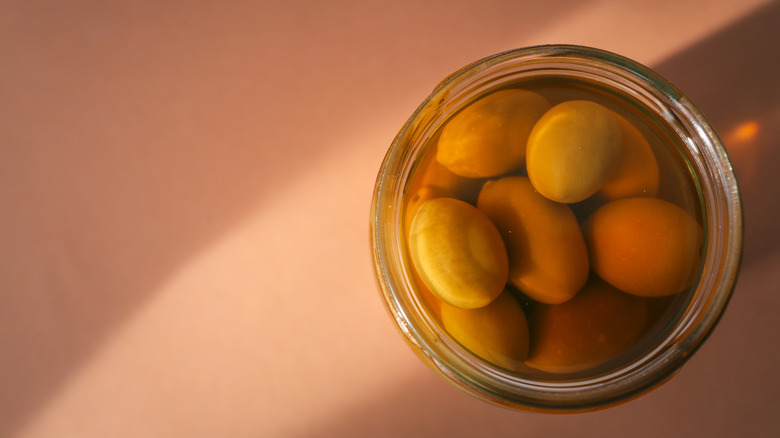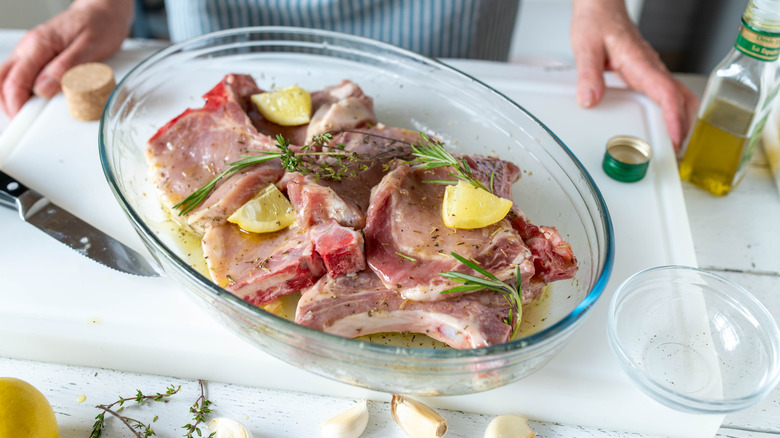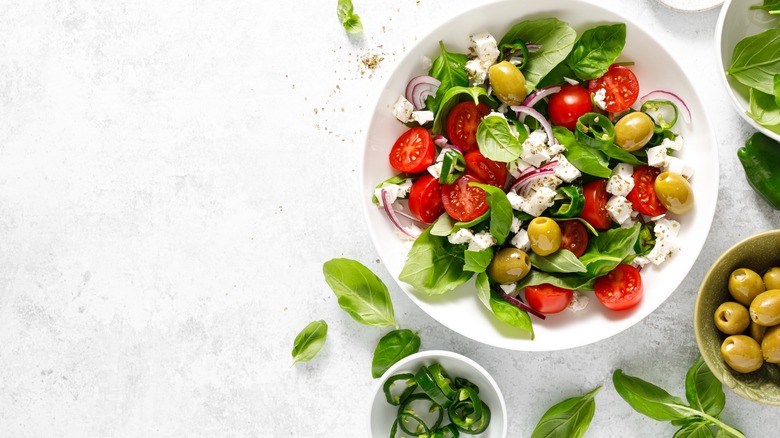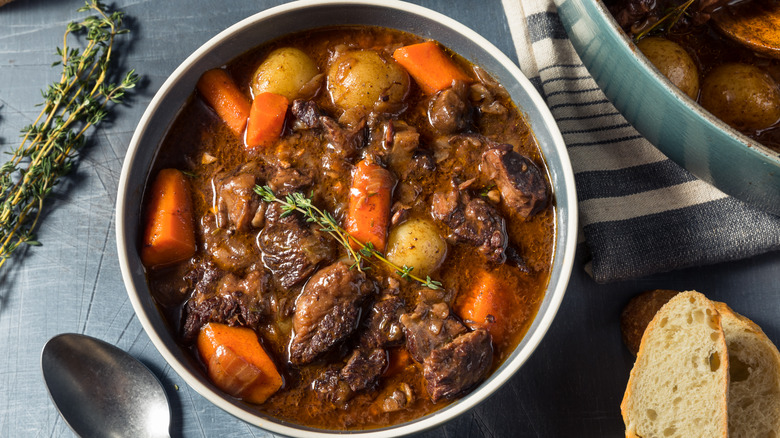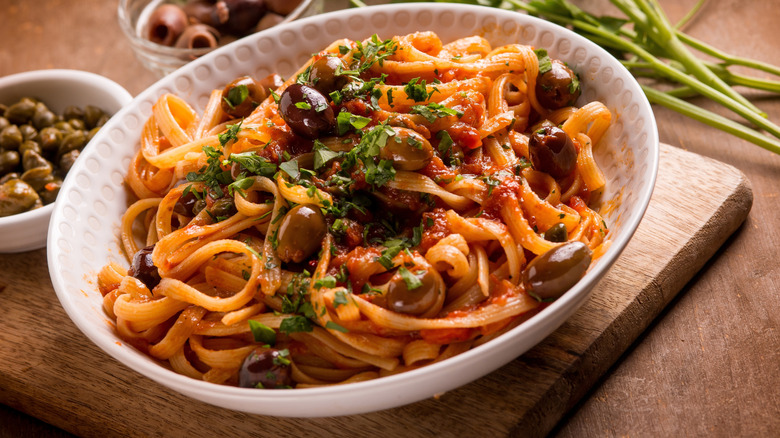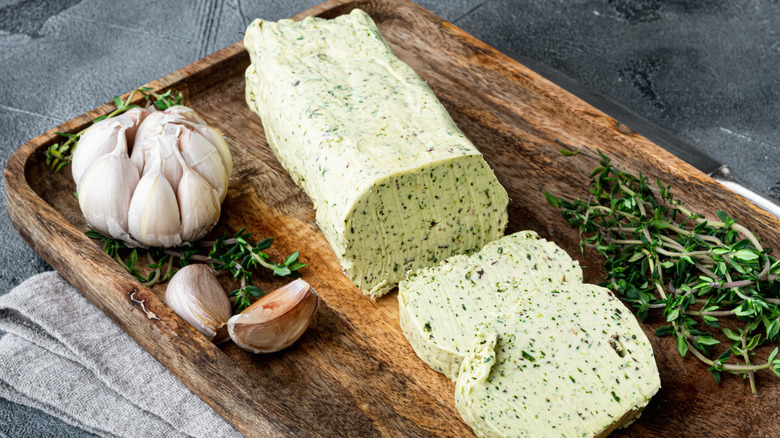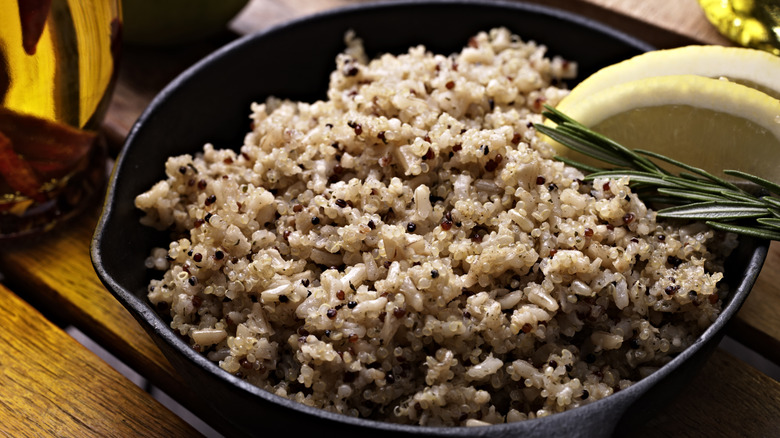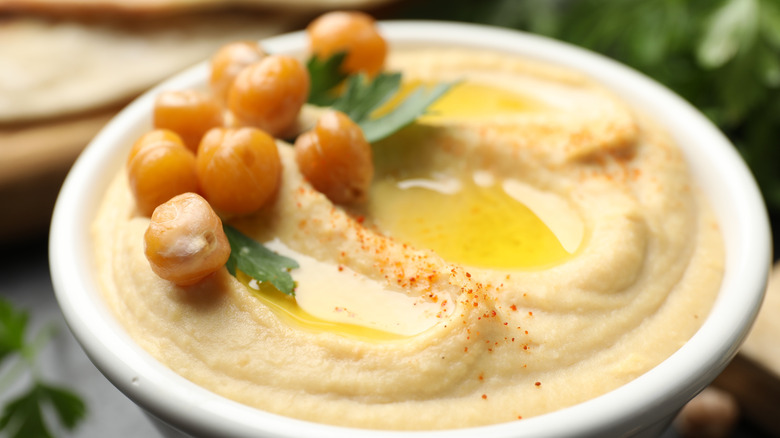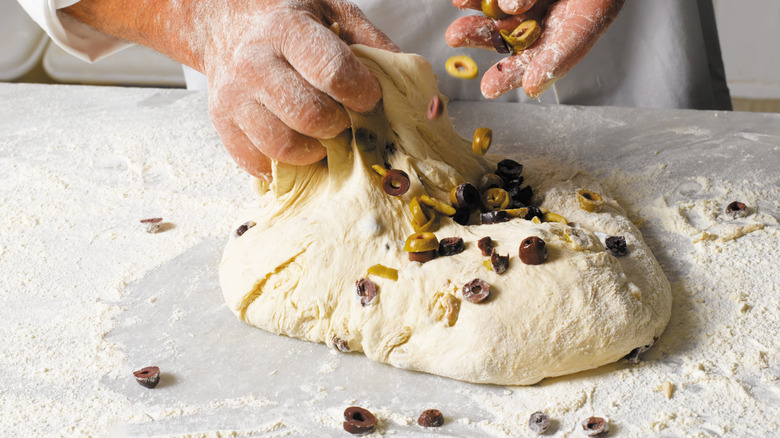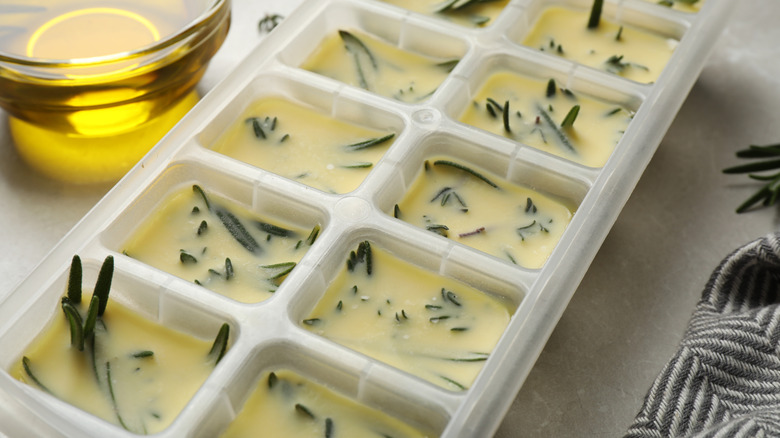12 Delicious Ways To Use Leftover Olive Brine
We may receive a commission on purchases made from links.
Don't pour that olive brine down the drain the next time you finish a jar of olives. There are countless ways you can reuse the salty brine that comes from a jar of olives to create dishes with maximum flavor. Although olive brine and olive juice are often used interchangeably, there is a difference between the two. Olive juice is pressed out of the olives while olive brine is the liquid left over in a jar of olives. If you don't want to buy a jar of olives for the brine, you can buy olive brine on its own from the store. There are several brands of olive juice or brine that are marketed for making cocktails, especially dirty martinis.
We've rounded up 12 ways to be thrifty in the kitchen by using your leftover olive brine. From cocktails to pasta to salad dressing, there are plenty of reasons to make sure you get all you can out of that jar of olives sitting in your refrigerator. Let our ideas be your inspiration, and use olive brine whenever you need to punch up a recipe with salty, rich flavor.
Add olive brine to a meat marinade for a salty addition
Whipping up a quick marinade for your meat is a convenient way to prep ahead for dinner. Your meat can sit and soak in the marinade until you are ready to throw it in the oven, on the grill, or in the pan. Marinades have the benefit of adding flavor to your meat and tenderizing it. Marinades are commonly made with acid, oil, spices, and other flavorings. Acid tenderizes the meat while the oil adds moisture and flavor. When you add a splash or two of olive brine to your marinade, you are adding salt, acidity, and flavor to the meat.
You can try adding a little olive brine to your marinade for extra flavor or use the olive brine as a base for your marinade. Either way, be mindful of how much salt you add because olive brine already contains a lot of salt. It's always a good idea to taste your marinade before adding it to raw meat. Another reason to taste it is that different olive brands have different flavors and varying levels of salt. Another idea beyond meat to consider is adding olive brine to tofu or vegetable marinades.
Make a dirty martini or revamp other cocktails with olive brine
You can always add a splash of olive brine to your martini for a dirty martini, but there are other cocktails that also benefit from an addition of olive brine. For a regular dirty martini, bartenders will typically add about 1 tablespoon of olive brine. If you'd like more, you can ask for "extra dirty." Adding olive brine to a traditional gin and dry vermouth martini adds a savory and salty taste to balance the drink with the slightest hint of olives.
You can also give your bloody Mary a tangy kick by adding olive brine. Try mixing in about 1 tablespoon of olive brine to your usual recipe and see what you think. You may want to experiment with the amount, but the olive brine will add a dash of saltiness to balance the sweetness in the tomato juice. The olive flavor goes well with a drink that often has green olives for garnishment. Another cocktail that uses olive brine is the Mexican martini, which is made with tequila, citrus juice, and olive brine.
Make a salty deviled egg
Deviled eggs are popular in the South, but their origin story goes back a lot further. A recipe for stuffed eggs was found dating back to the 13th century in Rome. In this early recipe, the yolk was removed from boiled eggs and mashed together with a raw egg, cloves, marjoram, and saffron. Next, the egg whites were filled with the mixture and fried with the yolk side down. It wasn't until the 18th century in England that they became deviled eggs. At the time, deviled meant heavily seasoned with spices. It was in America when jarred mayonnaise became popular that the deviled egg we know today started showing up in cookbooks and on people's tables in the 1950s and 1960s.
There are different variations of deviled egg recipes, but a common one is simply made and contains hard-boiled egg yolks mashed with mayonnaise, pickle relish, mustard, salt, and pepper. Some people garnish the finished deviled egg with a dash of paprika. If you'd like to add some salty flavor to your traditional deviled egg recipe, try mixing in 1 tablespoon or so of olive brine. You can even dice a handful of olives and add them to the mix for extra olive flavor.
Try a dirty martini-inspired salad dressing
You don't need a jarred, store-bought bottle of salad dressing to liven up your green salad. Sometimes a fresh and simple vinaigrette adds flavor and oil to salad greens, letting you taste the fresh, crispy vegetables without drowning them in a heavy, ingredient-laden dressing. It may be easier than you think to whip up a vinaigrette. A simple two-ingredient recipe involves mixing olive oil and either vinegar or citrus juice. However, you can try a variation on this by substituting the vinegar with leftover olive brine.
Olive brine usually contains vinegar, but it also has the added flavor from the olives that have been steeping in it. However, be wary of the salt levels. You likely won't need to add salt to your olive brine vinaigrette. The brine from either green olives or black olives will work well for this dressing. The flavors are distinctly different, but both will give you a tasty way to dress a fresh salad. Since vinaigrettes are usually made with one part acid (vinegar or citrus) to three parts oil, you can either replace the acid entirely with olive brine or just replace some of it.
Add to soups or stews
Umami is the fifth taste that brings a meaty, savory, salty flavor to food that contributes to our overall enjoyment while eating. It can be hard to identify exactly what umami is, and it's also a subjective taste. Some people think of umami as only appearing in Asian dishes, but it's a flavor sensation found in all types of cuisine. If you'd like to add some umami to your next hearty stew or soup, consider adding olive brine.
The olive taste mixes well with Mediterranean stews that already feature salty olives or capers in their ingredients. The salty brine would stand up to both beef and chicken stews. It's also an essential ingredient when making a classic Cuban picadillo. For another idea, try adding some olive brine to a hearty minestrone soup. If a recipe calls for olives, try mixing in a tablespoon or two of olive brine to your ingredients for a dose of umami. Note, you may need to adjust your salt level when adding a salty ingredient like olive brine.
Shake up your pasta recipe with a dose of olive brine
Try adding olive brine to bring a salty brightness to tomato-based dishes like marinara sauce or pasta puttanesca. While pasta puttanesca is an obvious choice since it already contains olives, you may be surprised by how adding a bit of olive brine to even a store-bought jar of marinara punches up the flavor. The briny olive taste will bring a unique depth to your pasta sauces.
To experiment with olive brine in your pasta sauces, make your sauce first. Once it's simmering on the stove, try adding a tablespoon or two of olive brine. Give it a taste after adding to keep control over the finished flavor before deciding if it could use a little more. But don't stop at tomato-based sauces. Olive brine can be added to creamy fettuccine sauce and even herby pestos for a dash of rich flavor.
Make an olive-infused butter
Butter is amazing on its own, but you can turn your regular meal into a gourmet one when you include a compound butter. It's not hard to do, but the flavors mixed in with the butter add an intensity to your dishes that will make them seem like you've spent a lot more time in the kitchen than you have. Compound butter can also be made ahead and frozen, adding to its convenience. To make it, you only need to mix your desired flavors into softened butter. Keep it in an airtight container and refrigerate or freeze. The uses are endless. You can spread it on bread, top it on vegetables or steak, spread it on corn on the cob, make a sandwich with it, top it on baked potatoes, or use it to sauté scrambled eggs.
Compound butter is often made with ingredients such as chopped fresh herbs, lemon juice or zest, or chili powder. Olive brine is another great addition to upgrade your butter. Try mixing a small amount of olive brine in softened butter, adding a little at a time until you get the texture and taste that you want. Once the olive brine is completely absorbed, refrigerate, and spread it on sandwiches, melt it over seafood dishes, or baste it over meat.
Add brine to the cooking water with your grains
Leftover olive brine can be thrown into boiling pasta water or cooking water for rice and other grains to add a savory depth. When you add brine to your rice or other grains, simply subtract the amount of water called for in the recipe from the amount of olive brine you want to add. You can choose to use olive brine from black olives or green olives, depending on what you are making and what your taste preferences are. A couple of tablespoons of brine from kalamata olives included in your rice will make a perfect side for a Greek chicken or pork dish. Be careful when salting your grain, as the brine will add salt, and you may not need any extra salt.
You can also include olive brine in your finished grains. For example, splash it on a Mediterranean quinoa salad for a salty, briny addition. Mediterranean quinoa salad is usually dressed with olive oil and citrus juice or vinegar, and an olive brine goes well with the bright, acidic flavors.
Mix olive brine into your hummus to add a new salty, depth to your dip
There is something inherently better about homemade hummus compared with what you buy from the store. While store-bought hummus is tasty and convenient, it's not too much effort to make your own. For an easy recipe, simply throw a can of drained chickpeas, 1 or 2 tablespoons of lemon juice, one garlic clove, and 1 or 2 tablespoons of olive oil into a blender. If you have tahini sauce on hand, you can add ¼ cup. Tahini sauce adds a beautiful, smooth texture and rich flavor, but you can make hummus without it, creating a friendly version for those with sesame nut allergies.
Finally, for our secret ingredient, add a spoonful of olive brine. Blend everything together on top speed until it has a nice and smooth texture. Add only a little olive brine at a time and taste it before you put in any more. Both green and black olive brine is delicious here, depending on the flavor you are looking for.
Add olive brine to olive bread
While fresh-baked bread is wonderful on its own, try making homemade olive bread for sandwiches or your next charcuterie board. The smell of fresh bread infused with olive flavor will fill your kitchen with wonderful, savory aromas. Traditional olive bread recipes don't require many ingredients and can be made the same way you would make a homemade crusty bread, with the addition of herbs, chopped olives, and sometimes cheese.
For a unique depth to your olive bread, try subbing out some of the water in the recipe with leftover olive brine. Do note that you should reduce or eliminate added salt if you follow this step. Aside from olive bread, subbing some of the water with brine for a focaccia bread recipe would also add seasoning and flavor. Again, be mindful of adding table salt when you do this. Try cutting your salt in half or even omitting it altogether. It may take some experimentation to find the best combination of ingredients.
Use as a salt brine for chicken
When you soak chicken in a salt brine solution before cooking, the meat begins to tenderize. The salt helps the muscle fibers in the chicken begin to break down and dissolve. The result is a tender, juicy, flavorful chicken after you cook it. It does require an extra step, but once you add the chicken to the brine water, let it sit for 12 to 24 hours in the refrigerator. Most chicken brining recipes call for boiling water, salt, sugar, and spices for about 20 to 30 minutes. Once the salt and sugar have dissolved, let the brine water cool to room temperature. After it reaches room temperature, cool it in the fridge for another 90 minutes. For food safety purposes, do not add the chicken to the salt brine until it is cold.
Next, add the chicken and let it sit for at least 12 hours, although most recipes recommend 24 hours for the best results. For a unique flavor addition, add some leftover olive brine to the water when you boil it. Or, for an even easier brine, simply add olive brine to a bowl and submerge the chicken. This is more of a marinade than a true brine, but it's a convenient method for giving your chicken a flavorful taste and adding moisture. Let it marinate for a few hours or overnight.
Freeze leftover olive brine in ice cube trays for later use
So you've finished a jar of olives, and you're left with the brine. You have plenty of ideas for what you want to do with your olive brine, but you don't need it right now. Rather than store the olive brine in the glass jar in your fridge, there is another solution. Simply pour the olive brine into ice cube trays and freeze.
Freezing food in ice cube trays helps prevent food waste and gives you a convenient option when you need to add a couple of tablespoons of something like tomato paste or herbs to your recipe. Standard ice trays hold two tablespoons per cube, giving you the perfect amount of olive brine at the ready for your next recipe. For extra convenience, buy ice cube trays that come with lids. Once the cubes are frozen, you can add them to airtight containers or freezer bags. The next time you want to add some olive brine to your pasta, stew, or soup, pop out a cube and throw it in your recipe.
